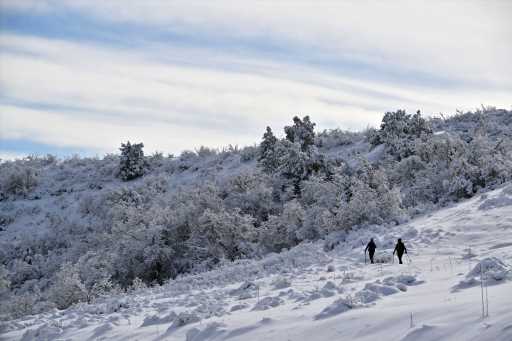Colorado snowpack good news for drought, but much more is needed
Colorado is enjoying above-average snowpack on its typically drought-stricken Western Slope, which is good news but the winter’s not yet over.
Recent rounds of snow mean more water for the state’s overtaxed reservoirs, maybe even enough to refill them to acceptable levels, but much still depends on the remaining winter months and how fast the snow melts off, Becky Bollinger, of Colorado State University’s Colorado Climate Center, said.
As of Thursday more than a third of the state (most of which sits west of the Continental Divide) is no longer considered to be suffering from drought conditions, according to the U.S. Drought Monitor. The remaining western portions of the state are considered “abnormally dry.”
Areas around Denver, Boulder and Fort Collins are 117% of normal snowpack levels for this time of year, according to data collected by the U.S. Department of Agriculture’s Natural Resources Conservation Services. Areas around Steamboat Springs sit at 150% of normal, and areas around Aspen, Gunnison and Durango are around 130%, 139% and 125% of normal levels, respectively.
Lagging behind is the San Luis Valley at 94% of normal and the southeast portion of the state, which sits at 81% of normal, the data shows.
Not only has the abundant snow been welcome news for the ski industry, but Bollinger said it’s also a good sign for the state’s dry creeks, rivers and reservoirs. A good snow year might be enough to replenish them but it’s still too early to tell whether the trend will continue.
She likened current snowpack levels to a football team finishing the second quarter in the lead.
“It’s really good when you’re winning at halftime, but you’ve still got to play the second half of the game,” Bollinger said.
The second half for Colorado includes February and March (traditionally the state’s snowiest month) and then April when the melt-off starts, Bollinger said. Should the snow melt too fast – like it did last year – much of the water won’t make it into the rivers and streams where it’s most needed. Instead, it will be absorbed by the parched soils or lost to evaporation.
The snow levels still aren’t enough to help the entire Colorado River Basin bounce back from its prolonged drought, though, Bollinger said. For that, the region would need more like a decade of record-setting snowfall, she said.
Source: Read Full Article


